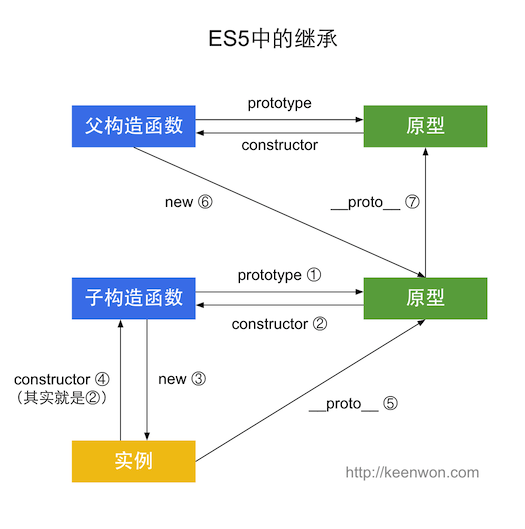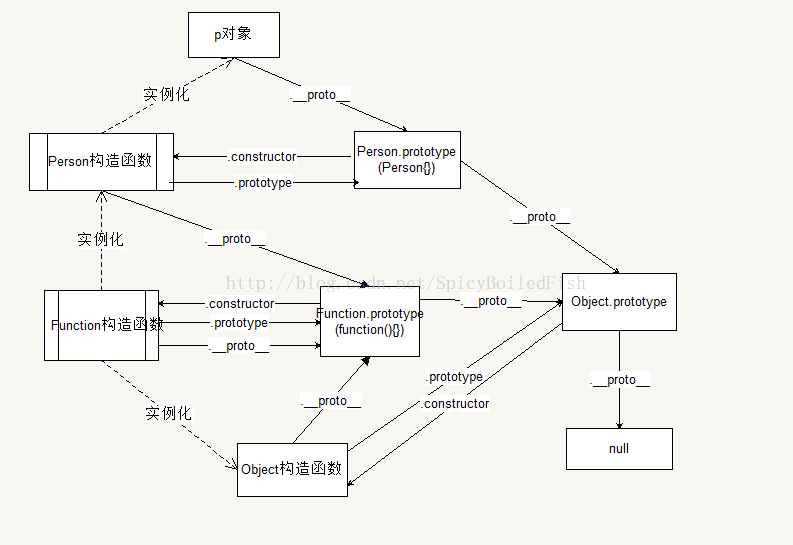js原型、原型链、继承相关学习心得
本文于995天之前发表,文中内容可能已经过时。
前置知识点:
- js基本数据类型和引用数据类型(基本数据类型有:
null,undefined,Boolen,Number,String,Symbol) - 计算机堆、栈内存(栈内存存的是基本类型和引用类型的地址,堆内存由于树状结构可以延伸适合引用类型如
Array,Object) - js中
this指向及bind,call,apply方法使用,参阅call、apply和bind的实现
引生思考点
- js语言原型和原型链为什么这么设计,好处与不好之处,与Java语言最大的区别是什么?
- 浅拷贝与深拷贝如何实现?
- js闭包知识点
js原型、原型链基本概念
ES5 和 ES6 继承的区别
ES5原型链继承

1 | function Super() { |
特点:
- 非常纯粹的继承关系,实例是子类的实例,也是父类的实例
instanceof方法通过层层查找原型链判断的
缺点:
- 来自原型对象的所有属性被所有实例共享
- 创建子类实例时,无法向父类构造函数传参
ES6继承

1 | class Super { |
- ES6继承和原型链式继承还是有本质区别的,ES6中
Son类实例是自己本身拥有了xxx属性的,因为在子类的constructor构造函数中运行super()方法调用了父类构造函数(ES5的调用父类构造函数继承) - ES6中方法都是不可枚举的,
Son类实例调用sayHello方法和原型式继承原理类似 - ES5中构造函数是function函数本身,而ES6中构造函数是
constructor函数 - 关于ES6
class可以重开一篇博客了, 先推荐阅读两篇文章
实现ES6的class语法(2019-06-26·补充)
1 | function inherit(subType, superType) { |
- ES6 的 class 内部是基于寄生组合式继承,它是目前最理想的继承方式,通过 Object.create 方法创造一个空对象,并将这个空对象继承 Object.create 方法的参数,再让子类(subType)的原型对象等于这个空对象,就可以实现子类实例的原型等于这个空对象,而这个空对象的原型又等于父类原型对象(superType.prototype)的继承关系
- 而 Object.create 支持第二个参数,即给生成的空对象定义属性和属性描述符/访问器描述符,我们可以给这个空对象定义一个 constructor 属性更加符合默认的继承行为,同时它是不可枚举的内部属性(enumerable:false)
- 而 ES6 的 class 允许子类继承父类的静态方法和静态属性,而普通的寄生组合式继承只能做到实例与实例之间的继承,对于类与类之间的继承需要额外定义方法,这里使用 Object.setPrototypeOf 将 superType 设置为 subType 的原型,从而能够从父类中继承静态方法和静态属性
ES5实现继承的其它方式
调用父类构造函数继承
1 | function Super(xxx) { |
特点:
- 创建子类实例时,可以向父类传递参数
缺点:
- 实例并不是父类的实例,只是子类的实例
- 只能继承父类的实例属性和方法,不能继承原型属性/方法
- 无法实现函数复用,每个子类都有父类实例函数的副本,影响性能
组合继承
1 | function Super(xxx) { |
特点:
- 创建子类实例时,可以向父类传递参数
- 既是子类的实例,也是父类的实例
- 实例拥有与父类同名的自己的属性(亦是缺点)
- 既能继承父类的实例属性和方法,又能继承原型属性/方法
缺点:
- 调用了两次父类构造函数,子类实例上属性将子类原型上的那份屏蔽了
寄生组合继承
1 | function Super(xxx) { |
特点:
- 结合以上所有继承方式的优点
完整的原型图

参考文章:
赏
 微信打赏
微信打赏
 微信打赏
微信打赏
赞赏是不耍流氓的鼓励
